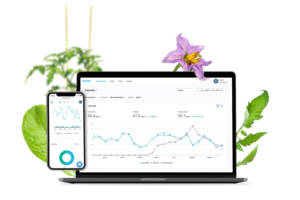Advances in protected cropping technology, particularly in semi-closed greenhouses and control systems based on artificial intelligence, enable nurseries to be built and crops produced in places where previously it would have been unfeasible to grow anything well or profitably.
Dutch high tech greenhouses are catching the attention of investors from outside the traditional horticultural industry who, particularly since the Covid-19 pandemic, can see opportunities for production nearer to markets to avoid the risks currently associated with international trade.
Production closer to large centres of population

Henk van Tuijl is the export manager at Kubo, the Dutch construction company which pioneered the semi-closed greenhouse.
“We are increasingly seeing projects that shift production closer to large centres of population,” said Henk van Tuijl, export manager at Kubo. This Dutch construction company pioneered the semi-closed greenhouse. “But often that includes trying to grow in places with no suitable land, water or other resources.”
Van Tuijl said the key advantage of the semi-closed greenhouse for such projects is the high level of control over-irrigation, heating or cooling, and air movement, making production possible in regions of the world where conventional structures can’t operate effectively.
FoodVentures
FoodVentures is one company securing investment for Dutch-led greenhouse projects in countries with climates that have, until now, ruled out year-round crops of fresh produce. They manage high tech greenhouses on an entire profit and loss responsibility. The first project involved growing lettuce on hydroponics in Ukraine. “Ukrainian workers were going to western Europe to work in greenhouses producing tomatoes, for example, which then exported back to Ukraine,” said CEO Dirk Aleven. “We thought we could work much more efficiently closer to the market.”
New projects involve nurseries in Georgia and Kazakhstan associated with Kubo and other greenhouse developers. With investment from a Chinese real-estate company, the latest venture is a 15ha five-greenhouse complex in Shanghai, built by Kubo.
“With Kubo, we know there is no next project if we are not successful with the current one,” said Aleven. “The project needs to be financially sustainable too. We are committed to building actual farms. When we made the greenhouse in Georgia, we used the same technology as our first one in Ukraine. But the difference in climate and geography meant we had to relearn how to use it completely.
“In Kazakhstan, we still have technical challenges. We grow tomatoes all year-round, where the climate ranges from 35°C in summer to -35°C in winter. But we now have experience in different climates – Kazakhstan is semi-desert, Georgia is hot and humid. We tell our colleagues at Kubo what we see in the crop and what we want to see, and they work out the technical adjustments to try to get the result we need.”
Analysing and presenting greenhouse data in the right way
Whether the greenhouse is conventional or semi-closed, climate control depends on input from various sensors. But the environmental and crop growth data these sensors generate can do more than just drive the climate control computer.
Analysed and presented in the right way, the data can help growers and their investors make more strategic decisions, too, said Marc Rooijakkers, business manager for Kubo’s spin-out operation PYLOT. The data management system gathers information collected by greenhouse sensors, reporting from the climate control computer and energy and water metres and interpreting it to give an overall picture of what’s going on with the five edible crops — tomatoes, peppers, cucumbers, aubergines and lettuce.
It also allows growers and managers to compare crop performance in various ways —such as yield per square metre and achieved humidity or use of light or labour on different sites.
All the data in one place


The PYLOT data management system gathers information collected by greenhouse sensors, the climate control computer and energy and water metres and interprets it to give an overall picture of what’s going on with five edible crops – tomatoes, peppers, cucumbers, aubergines and lettuce.
Its latest feature, ‘unrealised potential’, will give insights into what parameters can be adjusted to improve crop performance.
Dmitry Lashin, who operates 300ha of semi-closed greenhouses in the Lipetsk region of Russia, played a part in developing PYLOT. He says it reduces the risk associated with the level of investment in businesses of that size. “We needed a platform that can collect all the data in one place so we can know what happens in our greenhouses,” he said.
He calculates PYLOT has generated energy savings and productivity gains in the order of 10-15 per cent.
“I’m not a grower; I’m an investor and manager,” he explained. “The detailed data is there for growers who need to know if the temperature drops in in one part of the greenhouse. For me, the focus of the system is on the key performance indicators – how efficiently am I using our lighting or CO2 – and that is how we are achieving our performance gains.”
This article was first published in FloraCulture International in March 2022.










